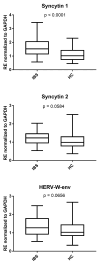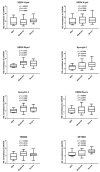Patients with Irritable Bowel Syndrome Exhibit Aberrant Expression of Endogenous Retroviruses and SETDB1
- PMID: 39936987
- PMCID: PMC11817187
- DOI: 10.3390/cells14030196
Patients with Irritable Bowel Syndrome Exhibit Aberrant Expression of Endogenous Retroviruses and SETDB1
Abstract
Irritable bowel syndrome (IBS) is a common disease, whose etiopathogenesis is poorly understood. Human endogenous retroviruses (HERVs) originate from ancient infections of germinal cells and represent 8% of our DNA. Most HERVs have become defective due to the accumulated mutations; some can, however, still be activated, and their altered expressions have been associated with a number of chronic inflammatory and immune-mediated disorders, including gastrointestinal diseases. Retroviral transcription is modulated by TRIM28 and SETDB1, which also participate in the regulation of epigenetic mechanisms and in shaping the immune system. Expressions of HERVs and TRIM28/SETDB1 have not been investigated in patients affected by IBS. Using a PCR real-time Taqman amplification assay, we explored the RNA levels of HERV-H-pol, HERV-K-pol, and HERV-W-pol; syncytin 1 (SYN1), SYN2, and HERV-W-env; and TRIM28 and SETDB1 in the peripheral blood of 37 IBS patients and healthy controls (HCs) of similar age. The transcript levels were higher in IBS patients than in HCs for all HERVs except for HERV-W-pol, with significant p-values for HERV-H-pol, HERV-K-pol, and SYN1 and borderline p-values for SYN2 and HERV-W-env. The RNA levels of SETDB1 were significantly enhanced in IBS patients, while those of TRIM28 were in the normal range. Patients with severe disease had significant upregulation of SETDB1 compared to those with mild or moderate symptoms. These findings suggest that overexpression of HERVs and SETDB1 may contribute to the development of IBS and open the way to innovative therapeutic strategies.
Keywords: SETDB1; TRIM28; human endogenous retroviruses; irritable bowel syndrome; pathogenesis.
Conflict of interest statement
The authors declare no conflicts of interest.
Figures




References
-
- Sperber A.D., Dumitrascu D., Fukudo S., Gerson C., Ghoshal U.C., Gwee K.A., Hungin A.P.S., Kang J.-Y., Minhu C., Schmulson M., et al. The global prevalence of IBS in adults remains elusive due to the heterogeneity of studies: A rome foundation working team literature review. Gut. 2017;66:1075–1082. doi: 10.1136/gutjnl-2015-311240. - DOI - PubMed
Publication types
MeSH terms
Substances
Grants and funding
LinkOut - more resources
Full Text Sources
Miscellaneous

